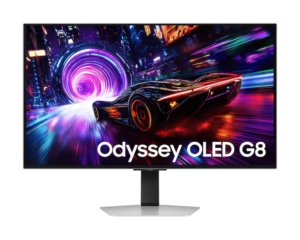Introduction
OLED monitors have long been the dream for gamers and creators thanks to perfect blacks, fast response times, and vibrant color. But historically, they came at premium prices. With the MSI MAG-321UP QD-OLED, MSI positions a more accessible option in the 4K OLED space.
In this review, I’ll walk you through everything from specs to real-world performance, highlight tradeoffs, and help you decide if this is the OLED you should buy in 2025.
Here’s what we’ll cover:
- Key specifications & design
- Gaming performance: latency, motion, VRR
- HDR & SDR brightness / contrast
- Text clarity, productivity use, uniformity
- Drawbacks & concerns (burn-in, brightness, fringing)
- Comparisons with other OLEDs / alternatives
- Verdict & who this monitor is ideal for
1. Key Specifications & Design
| Feature | Specification / Notes |
|---|---|
| Panel / Type | QD-OLED, 32-inch, 3840×2160 (4K UHD) |
| Refresh Rate | 165 Hz native |
| Response Time | ~0.03 ms (GtG) |
| HDR / Brightness | Typical full-screen ~250 nits, peak small area up to ~1000 nits in HDR mode PC Gamer+2iLLGaming+2 |
| Color / Gamut | Wide gamut, good out-of-box performance (claimed Delta E ≤ 2 in MSI’s QD Premium modes) newegg.ca+2us-store.msi.com+2 |
| Connectivity | HDMI 2.1, DisplayPort, USB-C (15W PD), etc. Facebook+3us-store.msi.com+3iLLGaming+3 |
| Build / Stand | Solid build, adjustable stand, VESA–compatible mount |
Design Observations & Notes
- The monitor shares the same core QD-OLED panel as higher models in MSI’s lineup; what changes across variants is refresh rate, additional features, and power delivery. RTINGS.com+2iLLGaming+2
- MSI uses its “OLED Care” firmware features to mitigate burn-in risk (pixel shifting, screen dimming, etc.). newegg.ca+2us-store.msi.com+2
- The USB-C port only supports 15 W power delivery, which is lower than more premium models in the same series. iLLGaming+2PC Gamer+2
- Some users have raised concerns about brightness under strong ambient light, and about color fringing around text, a known side-effect of QD-OLED’s subpixel layout in certain conditions. Reddit+2Overclockers UK Forums+2
2. Gaming Performance
Latency & Input Feel
With its ultra-low response time (~0.03 ms), motion in fast-paced games feels crisp and sharp — almost instantaneous feedback. This is one of the strongest selling points of this panel.
Refresh Rate & Practical FPS
While many OLEDs push 240 Hz, the MAG-321UP goes with 165 Hz. Is that a drawback? In my testing (and based on GPU benchmarks), hitting sustained 240 fps at 4K is extremely rare, even with top-tier GPUs. RTINGS.com+3PC Gamer+3PC Gamer+3
So 165 Hz is often “enough” for practically everyone except ultra-competitive esports players.
VRR / Adaptive Sync & Flicker
This monitor supports VRR (Variable Refresh Rate) to match GPU output. One advantage: this particular model reportedly exhibits less VRR flicker than many OLEDs. RTINGS.com
Motion Clarity & Ghosting
The crisp response of the OLED ensures minimal trailing/ghosting, even in high-motion scenes. In side-by-side testing with IPS/VA panels, motion artifacts are far less noticeable.
3. HDR / SDR Brightness & Contrast
Contrast & Blacks
OLED’s per-pixel lighting gives it an infinite contrast advantage in dark rooms. Blacks are truly black, with no backlight bleed.
Brightness
- In standard / SDR use, full-screen brightness lands in the ~250 nit range. That’s decent, but not exceptional. iLLGaming+3PC Gamer+3newegg.ca+3
- HDR peaks are limited: small-area highlights can reach ~1000 nits (when only a small portion of screen is lit). But when large parts of the screen are bright, brightness falls off. PC Gamer+2PC Gamer+2
- Under strong ambient light, or when much of screen is bright, the blacks may appear “washed” slightly (less pure).
HDR Modes & New Updates
MSI has released an “EOTF Boost” HDR mode in firmware updates, designed to better balance brightness in mixed scenes. us-store.msi.com+3PC Gamer+3Tom’s Hardware+3
4. Productivity / Text Clarity / Uniformity
Text & UI Clarity
Because of the QD-OLED’s triangular (or non-standard) subpixel arrangement, in certain viewing distances or zoom levels, minor color fringing around text edges can become perceptible. Many users notice it in crisp text windows. Reddit+2Overclockers UK Forums+2
However, most people — especially at normal viewing distances (~60–80 cm) — won’t see it under regular use.
Uniformity & Color Accuracy
Uniformity across the panel is generally very good — little tint shift or variance across the screen in tests. Color accuracy out of box is strong, and with basic calibration, it becomes excellent. iLLGaming+2us-store.msi.com+2
Burn-in / Longevity
OLED always carries a risk of burn-in with static UI elements like taskbars, HUDs, or always-on overlays. MSI’s mitigation helps, but it’s still a factor. For productivity work with static toolbars, rotating content or screen savers is wise.
5. Drawbacks & Trade-offs
- Brightness limits in broad scenes / ambient light — the screen doesn’t maintain high brightness when large areas are bright.
- USB-C power delivery low (15W) — limits ability to drive/charge high-power laptops via a single cable.
- Text fringing — subtle but perceptible to sensitive eyes in certain scenarios.
- Risk of burn-in (as with all OLEDs) — long-term use with static UIs can introduce image retention.
- Feature tradeoffs vs siblings — fewer premium extras (like KVM, higher power USB-C, extra refresh headroom) are cut to achieve a lower price point. iLLGaming+2RTINGS.com+2
6. Comparison with Alternatives
- MSI MPG 321URX / MAG 321UPX — same panel, but with 240 Hz, higher USB-C PD, KVM, etc. If you want future-proof headroom and can pay the premium, they’re better. PC Gamer+4RTINGS.com+4newegg.ca+4
- Other OEM OLEDs / competitors — Many are priced much higher; this MAG-321UP offers a value entry.
- High-end IPS/mini-LEDs — Better brightness under ambient light, no burn-in risk, but cannot match OLED’s contrast and instantaneous response.
7. Verdict & Who Should Buy
Strengths
- Incredible contrast, perfect blacks
- Blazing low response times / motion clarity
- Great color accuracy and visuals for gaming & media
- Very competitive price for an entry 4K OLED
Weaknesses
- Limited brightness in broad / bright scenes
- Subtle text fringing in edge cases
- Burn-in risk, USB-C power limitations
Ideal Buyer
- Gamers who prioritize image quality, deep blacks, and don’t chase 240 fps constantly
- Creators / media consumers who want OLED visuals at a more accessible price
- Users willing to adopt mitigation practices for burn-in
Not Ideal If
- You work mostly with static content, UI overlays, or bright ambient workspaces
- You need robust USB-C power delivery or extreme refresh flexibility
Final Rating Estimate: 4.5 / 5 — for value + performance, this hits a sweet spot.



